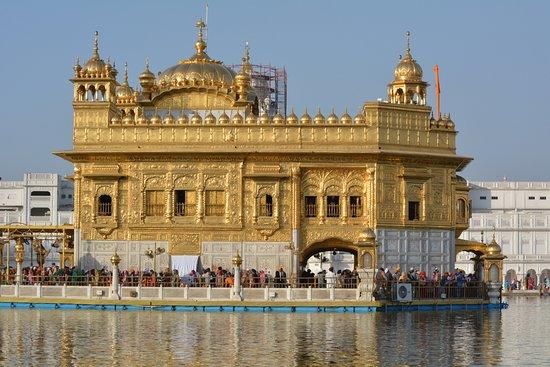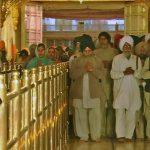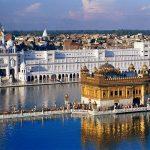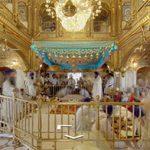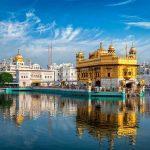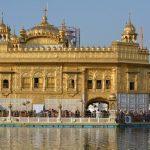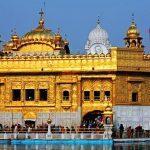Contents
Golden Temple, Amritsar, Punjab
| Date built: | August 1604 |
|---|---|
| Deity: | – |
| Architectural style: | – |
| Major festivals | – |
| Locale: | – |
| District:: | Amritsar |
| Address: | Golden Temple Rd, Atta Mandi, Katra Ahluwalia, Amritsar, Punjab 143006 |
| Phone | 01832553957 |
The Golden Temple, also known as Darbar Sahib or Sri Harmandir Sahib is a Gurdwara located in the city of Amritsar, Punjab, India.It is the holiest Gurdwara and the most important pilgrimage site of Sikhism.
The temple is built around a man-made pool (sarovar) that was completed by Guru Ram Das in 1577. Guru Arjan – the fifth Guru of Sikhism, requested Sai Mian Mir – a Muslim Pir of Lahore to lay its foundation stone in 1589.In 1604, Guru Arjan placed a copy of the Adi Granth in Harmandir Sahib, calling the site Ath Sath Tirath (lit. “shrine of 68 pilgrimages”).The temple was repeatedly rebuilt by the Sikhs after it became a target of persecution and was destroyed several times by the Muslim armies from Afghanistan and the Mughal Empire.The army led by Ahmad Shah Abdali, for example, demolished it in 1757 and again in 1762, then filled the pool with garbage.Maharaja Ranjit Singh after founding the Sikh Empire, rebuilt it in marble and copper in 1809, overlaid the sanctum with gold foil in 1830. This has led to the name the Golden Temple.
The temple is spiritually the most significant shrine in Sikhism. It became a center of the Singh Sabha Movement between 1883 and 1920s. In the early 1980s, the temple became a center of conflict between the Indian government led by Indira Gandhi, some Sikh groups and a militant movement led by Jarnail Singh Bhindranwale seeking to create a new nation named Khalistan. In 1984, Gandhi sent in the Indian Army as part of Operation Blue Star, leading to deaths of over 1,000 militants, soldiers and civilians, as well as causing much damage to the temple and the destruction of Akal Takht. The temple complex was rebuilt again after the 1984 damage.
The Harmandir Sahib is an open boat of worship for all men and women, from all walks of life and faith. It has a square plan with four entrances, has a circumambulation path around the pool. The temple is a collection of buildings around the sanctum and the pool. One of these is Akal Takht, the chief center of religious authority of Sikhism. Additional buildings include a clock tower, the offices of Gurdwara Committee, a Museum and a langar – a free Sikh community run kitchen that serves a simple vegetarian meal to all visitors without discrimination.Over 100,000 people visit the holy shrine daily for worship.The temple complex has been nominated as a UNESCO World Heritage Site, and its application is pending on the tentative list of UNESCO.
Architecture
According to the Sikh historical records, the land that became Amritsar and houses the Harimandar Sahib was chosen by Guru Amar Das– the third Guru of the Sikh tradition. It was then called Guru Da Chakk, after he had asked his disciple Ram Das to find land to start a new town with a man made pool as its central point. After Ram Das succeeded Guru Amar Das in 1574, and given the hostile opposition he faced from the sons of Guru Amar Das,Guru Ram Das founded the town that came to be known as “Ramdaspur”. He started by completing the pool with the help of Baba Buddha (not to be confused with the Buddha of Buddhism). Guru Ram Das built his new official centre and home next to it. He invited merchants and artisans from other parts of India to settle into the new town with him.
Ramdaspur town expanded during the time of Guru Arjan financed by donations and constructed by voluntary work. The town grew to become the city of amristsar , and the pool area grew into the Golden Temple complex.The construction activity between 1574 and 1604 is described in Mahima Prakash Vartak, a semi-historical Sikh hagiography text likely composed in 1741, and the earliest known document dealing with the lives of all the ten Gurus.Guru Arjan installed the scripture of Sikhism inside the new temple in 1604.Continuing the efforts of Guru Ram Das, Guru Arjan established Amritsar as a primary Sikh pilgrimage destination. He wrote a voluminous amount of Sikh scripture including the popular Sukhmani Sahib
Legend / Local stories
According to the Sikh historical records, the land that became Amritsar and houses the Harimandar Sahib was chosen by Guru Amar Das– the third Guru of the Sikh tradition. It was then called Guru Da Chakk, after he had asked his disciple Ram Das to find land to start a new town with a man made pool as its central point. After Ram Das succeeded Guru Amar Das in 1574, and given the hostile opposition he faced from the sons of Guru Amar Das,[20] Guru Ram Das founded the town that came to be known as “Ramdaspur”. He started by completing the pool with the help of Baba Buddha (not to be confused with the Buddha of Buddhism). Guru Ram Das built his new official centre and home next to it. He invited merchants and artisans from other parts of India to settle into the new town with him.
Ramdaspur town expanded during the time of Guru Arjan financed by donations and constructed by voluntary work. The town grew to become the city of amristsar , and the pool area grew into the Golden Temple complex.The construction activity between 1574 and 1604 is described in Mahima Prakash Vartak, a semi-historical Sikh hagiography text likely composed in 1741, and the earliest known document dealing with the lives of all the ten Gurus. Guru Arjan installed the scripture of Sikhism inside the new temple in 1604. Continuing the efforts of Guru Ram Das, Guru Arjan established Amritsar as a primary Sikh pilgrimage destination. He wrote a voluminous amount of Sikh scripture including the popular Sukhmani Sahib
Photo Gallery
How to Reach:
Contact Details
Official Address

